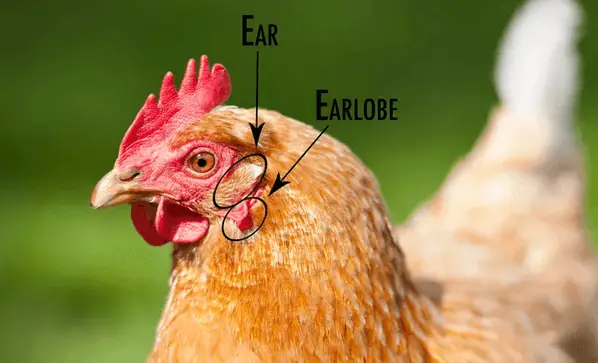Do chickens have ears? It’s not all that strange of a question, and in fact, quite a good one. After all, when you visualize a chicken in your head, you don’t usually think of them as having ears.
But is this really the case? There are many animals out there that at first glance do not appear to have ears, but if you look closer they most definitely do have them. I was curious about this too, so I did a lot of research on the topic to give you a definitive answer to this question!
As I found out, chickens do indeed have ears, they’re located on the sides of their head. However, they’re normally hidden behind their feathers which is why you do not often see them. If you want to take a look, you can push aside the feathers on the side of their head and you’ll see an opening, that’s their ear canal. They also have earlobes which can be different colors and are more visible. Chicken ears are sensitive and they have a strong sense of hearing.
Keep reading and I’ll tell you everything you need to know about chickens and their ears! Of course, I’ll also show you some pictures.
What do chicken ears look like?
The ear of the chicken is made up of eardrums, the outer, middle, and inner ear, and their earlobes.
The makeup of their ears is quite similar to our own, except that everything is on the inside of their head while our ears protrude. The only part of the chicken ear that’s very visible are their earlobes which you can see hanging from their head. The rest just looks like a tiny hole in the side of their head.
To get a good idea of what their ears look like a picture is much better than a lengthy description so I recommend you take a look at the image below.

If you’re curious what their earlobes look like, take a look at the following image:

Where are the chicken’s ears?
The ears of the chicken can be found on the sides of their head, slightly lower than their eyes. The reason why they are located there is that it allows them to pick up sounds from all directions, which was essential as a warning system back when they lived in the wild.
As I’ve already mentioned, their ears are covered by feathers, so you won’t see them unless you’re actively looking for them.
The image above provides a good idea of where you can find them on the head of the chicken.
Earlobes determine egg color
The earlobes of chickens can be different colors and believe it or not, this is what affects the color of their eggs. If you have a chicken with white earlobes then they will lay white eggs, if you have a chicken with red earlobes then they will lay brown eggs.
There are some exceptions to this rule, some chickens with red earlobes can lay blue or greenish colored eggs, but in general this rule holds firm.
Scientists are not quite sure why this correlation happens but believe that it might be because the genes for earlobe and eggshell color are close together. It’s been discovered that eggs all start out white and then the pigment from the chicken gives their shells their different colors. Because of this, all chicken eggs are essentially the same, they just have a different appearance. They have the same nutrition, no matter if they’re white, brown, or blue!
Fun fact: the color of their earlobe also affects the color of the rest of their ear. If your chicken has red lobes then their ear will also be red!
Do chickens have good hearing?
Chickens have evolved to be quite low on the food chain. In nature, they had many predators and because of this, they needed strong hearing to alert them when predators were nearby. While nowadays most chickens are either kept as pets or as farm animals and don’t really need strong hearing any more, they still retain their excellent hearing capabilities.
Most humans will experience some form of hearing loss in their lives, but chickens will not. Since their hearing was so important for them they evolved to be able to repair their hearing cells. This was crucial because a deaf chicken would become a dead chicken in the wild in no time. After all, without their strong hearing, they wouldn’t be able to hear predators coming and would not be able to flee in time.
The hearing of chickens is so strong that they can quite accurately estimate how far away a sound is by timing how long it takes before the sound reaches their left ear after reaching their right ear (or vice versa). Also, an interesting fact is that chickens seem to respond well to music. A study has shown that exposure to classical music can make them less fearful.
Baby chickens
Baby chickens have ears too. They start developing them when they’re still in the shell. In fact, they can start hearing their mother on day 12 of the incubation period! When chicks hatch, they are born with their ears fully intact and functioning. They can hear as soon as they’re born.
This is important because they need to communicate with their mother. Studies have shown that even when chicks are raised without a hen you can use auditory cues such as tapping to help them identify food sources. These auditory cues imitate the pecking noise of a mother hen which lets the chicks know that there’s a source of food nearby.
Final words
So, now you know everything you’ve ever wanted to know about chickens and their ears. We’ve discovered that they do indeed have them, where they are located, and that they have quite a strong sense of hearing. Interestingly enough, the color of their eggs seems to be determined by the color of their earlobes. Also, chicks are capable of hearing their mother when they’re still in the egg, quite remarkable!
I hope this overview was informative and that you learned something new! If you feel like I’ve missed something that you would like me to add, feel free to leave a comment.
- How Long Do American Eskimo Dogs Live? Important Factors and Care Tips - September 29, 2023
- Do American Bulldogs Need Grooming? Essential Tips and Care Guidelines - September 29, 2023
- Do Bengal Cats Enjoy Playing? Essential Tips for Keeping Them Active - September 29, 2023